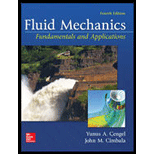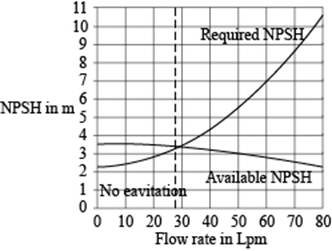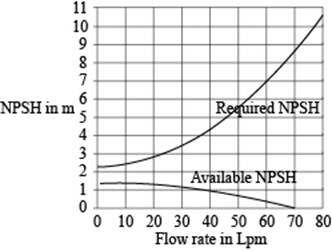
Repeat Prob. 14-60. but at a water temperature of 80°C. Repeat for 90°C. Discuss.
The maximum volume flow rate at which cavitation occur.
Answer to Problem 61P
The maximum volume flow rate at which cavitation occur is
Explanation of Solution
Given information:
The temperature of the water is
Write the expression for the required head using the energy balance equation.
Here, the initial pressure is
Write expression for the available net positive suction head at the pump inlet.
Here, the saturation pressure is
Write the expression for the minor losses.
Here, the minor loss coefficient due to sharp edge is
Write the expression for the velocity of the water.
Write the expression for the Reynolds number.
Here, the density of the water is
Write the expression for the minor losses.
Write the expression for the required net positive suction head.
Write the expression for the friction factor.
Here, the friction factor is
Calculation:
Refer to the Table-A-7E, "Properties of saturated liquid" to obtain the density of the water as
Substitute
Substitute
Use hit and trial method to obtain the volume flow rate.
Iteration 1 consider the volume flow rate as
Substitute
Substitute
Substitute
Substitute
Substitute
Since, the available net positive suction head is greater than the required net positive suction head hence, cavitation does not occur at this flow rate.
The different iteration are shown in the below Table.
| S.No | |||
| 1 | |||
| 2 | |||
| 3 | |||
| 4 | |||
| 5 | |||
| 6 | |||
| 7 | |||
Draw the plot between the flow rate and available net positive suction head and the required net positive suction head.

Figure-(1)
Figure-(1) shows that the cavitation occur at volume flow rates above the
Refer to the Table-A-7E, "Properties of saturated liquid" to obtain the density of the water as
Substitute
Substitute
Use hit and trial method to obtain the volume flow rate.
Iteration 1 consider the volume flow rate as
Substitute
Substitute
Substitute
Substitute
Substitute
Since, the available net positive suction head is greater than the required net positive suction head hence, cavitation does not occur at this flow rate.
The different iteration are shown in the below Table.
| S.No | |||
| 1 | |||
| 2 | |||
| 3 | |||
| 4 | |||
| 5 | |||
| 6 |
Draw the plot between the flow rate and available net positive suction head and the required net positive suction head.

Figure-(2)
From Figure-(2), available net positive suction head and the required net positive suction head curves are not crossing each other as the temperature of water is near to boiling temperature. The pump cavitates at any flow rate.
Conclusion:
The maximum volume flow rate at which cavitation occurs is
Want to see more full solutions like this?
Chapter 14 Solutions
Fluid Mechanics: Fundamentals and Applications
- Can you provide steps and an explaination on how the height value to calculate the Pressure at point B is (-5-3.5) and the solution is 86.4kPa.arrow_forwardPROBLEM 3.46 The solid cylindrical rod BC of length L = 600 mm is attached to the rigid lever AB of length a = 380 mm and to the support at C. When a 500 N force P is applied at A, design specifications require that the displacement of A not exceed 25 mm when a 500 N force P is applied at A For the material indicated determine the required diameter of the rod. Aluminium: Tall = 65 MPa, G = 27 GPa. Aarrow_forwardFind the equivalent mass of the rocker arm assembly with respect to the x coordinate. k₁ mi m2 k₁arrow_forward
- 2. Figure below shows a U-tube manometer open at both ends and containing a column of liquid mercury of length l and specific weight y. Considering a small displacement x of the manometer meniscus from its equilibrium position (or datum), determine the equivalent spring constant associated with the restoring force. Datum Area, Aarrow_forward1. The consequences of a head-on collision of two automobiles can be studied by considering the impact of the automobile on a barrier, as shown in figure below. Construct a mathematical model (i.e., draw the diagram) by considering the masses of the automobile body, engine, transmission, and suspension and the elasticity of the bumpers, radiator, sheet metal body, driveline, and engine mounts.arrow_forward3.) 15.40 – Collar B moves up at constant velocity vB = 1.5 m/s. Rod AB has length = 1.2 m. The incline is at angle = 25°. Compute an expression for the angular velocity of rod AB, ė and the velocity of end A of the rod (✓✓) as a function of v₂,1,0,0. Then compute numerical answers for ȧ & y_ with 0 = 50°.arrow_forward
- 2.) 15.12 The assembly shown consists of the straight rod ABC which passes through and is welded to the grectangular plate DEFH. The assembly rotates about the axis AC with a constant angular velocity of 9 rad/s. Knowing that the motion when viewed from C is counterclockwise, determine the velocity and acceleration of corner F.arrow_forward500 Q3: The attachment shown in Fig.3 is made of 1040 HR. The static force is 30 kN. Specify the weldment (give the pattern, electrode number, type of weld, length of weld, and leg size). Fig. 3 All dimension in mm 30 kN 100 (10 Marks)arrow_forward(read image) (answer given)arrow_forward
- A cylinder and a disk are used as pulleys, as shown in the figure. Using the data given in the figure, if a body of mass m = 3 kg is released from rest after falling a height h 1.5 m, find: a) The velocity of the body. b) The angular velocity of the disk. c) The number of revolutions the cylinder has made. T₁ F Rd = 0.2 m md = 2 kg T T₂1 Rc = 0.4 m mc = 5 kg ☐ m = 3 kgarrow_forward(read image) (answer given)arrow_forward11-5. Compute all the dimensional changes for the steel bar when subjected to the loads shown. The proportional limit of the steel is 230 MPa. 265 kN 100 mm 600 kN 25 mm thickness X Z 600 kN 450 mm E=207×103 MPa; μ= 0.25 265 kNarrow_forward
 Principles of Heat Transfer (Activate Learning wi...Mechanical EngineeringISBN:9781305387102Author:Kreith, Frank; Manglik, Raj M.Publisher:Cengage Learning
Principles of Heat Transfer (Activate Learning wi...Mechanical EngineeringISBN:9781305387102Author:Kreith, Frank; Manglik, Raj M.Publisher:Cengage Learning Refrigeration and Air Conditioning Technology (Mi...Mechanical EngineeringISBN:9781305578296Author:John Tomczyk, Eugene Silberstein, Bill Whitman, Bill JohnsonPublisher:Cengage Learning
Refrigeration and Air Conditioning Technology (Mi...Mechanical EngineeringISBN:9781305578296Author:John Tomczyk, Eugene Silberstein, Bill Whitman, Bill JohnsonPublisher:Cengage Learning

